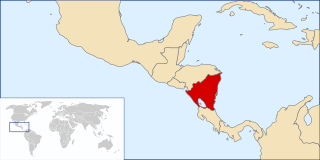
The Federal Republic of Central America, initially known as the United Provinces of Central America, was a sovereign state in Central America that existed between 1823 and 1839/1841. The republic was composed of five states, and a Federal District from 1835 to 1839. Guatemala City was its capital city until 1834, when the seat of government was relocated to San Salvador. The Federal Republic of Central America was bordered on the north by Mexico, on the south by Gran Colombia and on its eastern coastline by the Mosquito Coast and British Honduras, both claimed by the federal republic.

La Llorona is a vengeful ghost in Mexican folklore who is said to roam near bodies of water mourning her children whom she drowned in a jealous rage after discovering her husband was unfaithful to her. Whoever hears her crying either suffers misfortune or death and their life becomes unsuccessful in every field.

Sergio Ramírez Mercado is a Nicaraguan writer and intellectual who was a key figure in 1979 revolution, served in the leftist Government Junta of National Reconstruction and as vice president of the country 1985–1990 under the presidency of Daniel Ortega. He has been described as Nicaragua's "best-known living writer". Since the 1990s, he has been involved in the left-wing opposition to the Nicaraguan government, in particular in the Movimiento de Renovación Sandinista. He was exiled from the country in 2021 and stripped of his nationality by the government in 2023.

The Cegua, La Sihuehuet or Siguanaba, Cigua or Siguanaba is a supernatural character from Central American folklore, though it can also be heard in Mexico. It is a shapeshifting spirit that typically takes the form of an attractive, long haired woman seen from behind. She lures men away into danger before revealing her face to be that of a horse or, alternatively, a skull.
The Chilote mythology or Chilota mythology is formed by the myths, legends and beliefs of the people who live in the Chiloé Archipelago, in the south of Chile. This mythology reflects the importance of the sea in the life of Chilotes.

The Guadalajara International Film Festival is a week-long film festival held each March in the Mexican city of Guadalajara since 1986.

The following is an alphabetical list of topics related to Nicaragua.

Mexico has a variety of cultures which came from European and Mesoamerican cultures. This mix of cultures leads to the creation of traditional tales and narrations better known as myths and legends.
Jhonny Cubero Quesada is a Costa Rican professional footballer who last played for Coatepeque in Guatemala.
Marcela Donoso Concha is a Chilean painter, belonging to the Magical Realism movement.
Víctor Roberto Webster Flashy is a retired Nicaraguan footballer.
The Real Audiencia of Santiago de Guatemala, simply known as the Audiencia of Guatemala or the Audiencia of Los Confines, was a Real Audiencia in the Imperial Spanish territory in Central America known as the Captaincy General of Guatemala (1609-1821). The Audiencia's presiding officer, the president, was the head of the government of the area. The Audiencia was initially created by decrees of November 20, 1542 and September 13, 1543, and had its seat in Antigua Guatemala.

The Guatemala women's national football team is controlled by the Federación Nacional de Fútbol de Guatemala. They are one of the top women's national football teams in the Central American region along with Costa Rica, having won the 1999 UNCAF championship.

Knowledge of Muisca mythology has come from Muisca scholars Javier Ocampo López, Pedro Simón, Lucas Fernández de Piedrahita, Juan de Castellanos and conquistador Gonzalo Jiménez de Quesada who was the European making first contact with the Muisca in the 1530s.

Miguel Ángel Asturias Rosales was a Guatemalan poet-diplomat, novelist, playwright and journalist. Winning the Nobel Prize in Literature in 1967, his work helped bring attention to the importance of indigenous cultures, especially those of his native Guatemala.
Below are listed all the matches played by the Costa Rica national football team between 2010 and 2019.

The following lists events that happened during 2020 in Central America: Belize, Costa Rica, El Salvador, Guatemala, Honduras, Nicaragua, and Panama.

From January 1822 to July 1823, the Captaincy General of Guatemala, a former Spanish colony, was controlled by the First Mexican Empire, and briefly, the Supreme Executive Power—the provisional government that succeeded Mexican imperial rule. The captaincy general consisted of the provinces of Chiapas, Costa Rica, El Salvador, Guatemala, Honduras, and Nicaragua—the six southernmost provinces of the Mexican Empire. The incorporation of Central America brought Mexico to the height of its territorial extent.
Christian Antonio Reyes Alemán is a professional footballer who plays as a centre-back for the Costa Rican club Pérez Zeledón, on loan from Herediano. Born in Costa Rica, he plays for the Nicaragua national team.












